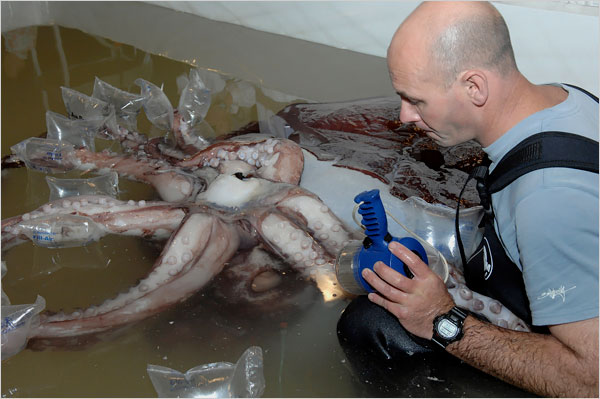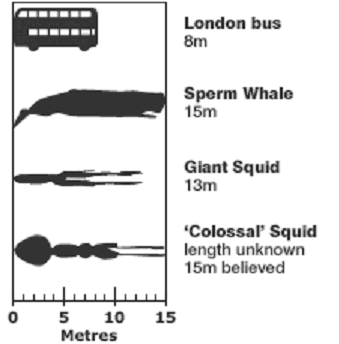By
Richard Black
Environment correspondent, BBC News website

The huge eye of the world's largest squid has
been revealed by scientists
dissecting
a rare, intact half-tonne
specimen in
New Zealand.
About 27cm (11in) across, researchers believe
the colossal squid's eye is the biggest animal eye ever
found. The 10m-long (34ft) specimen has also turned out to
be female, surprising the scientific team. Very little is
known about colossal squid; only about 10 have ever been
caught and brought to shore. This one was caught by
fishermen in the
Ross Sea near Antarctica last year.
Scientists hope the dissection will yield new
information about where and how colossal squid (Mesonychoteuthis
hamiltoni) live and breed.
"These are truly amazing eyes," commented Eric
Warrant from the
University of Lund in Sweden, an expert on animal vision
who is at the
Museum
of New Zealand Te Papa in Wellington to take part in the
dissection.
"In the collapsed state we see here, they
measure 25cm across; but in the living animal they are
probably larger, up to around 30 cm." With a diameter
larger than a football, these would help the fearsome
hunters locate prey in the dark Southern Ocean depths. The
pupils alone are about 8cm (3in) across
"These are without doubt the largest eyes that
have ever been studied, and probably among the largest
eyes that have existed during the history of the animal
kingdom," Professor Warrant concluded.

Hooked on food
The 10-strong team of researchers had
initially believed the colossal squid to be male. Instead,
they found ovaries containing thousands of eggs. This may
have implications for understanding how big the creatures
can grow.
Females are thought to be larger; so if this
had been a 10-metre male, it would have been logical to
assume there were much bigger specimens out there. The
creature's lower beak has also emerged, and measures about
4cm across.

Scientists have also been able to examine in
more detail the swivelling barbed clubs at the end of its
tentacles.
"It's endowed with a killer
arsenal: the
hooks, the beak, everything about it," observed
Steve O'Shea from the
University of Technology in Auckland.
A endoscope has been inserted down into the
animal's stomach in the hope of identifying what it had
been eating before it was caught.
The team is also dissecting a much smaller
colossal squid specimen that has part of its body missing,
and a giant squid - a member of the Architeuthis
genus.
Architeuthis
can be as long as colossal squid, but their bodies are
smaller and thinner.
Neither of these marine monsters is frequently
seen, but Mesonychoteuthis is especially elusive.
Later in the week, the team is expected to give public
lectures about the initial results. Once thawed and
examined, the squid will be embalmed and preserved.
![]()